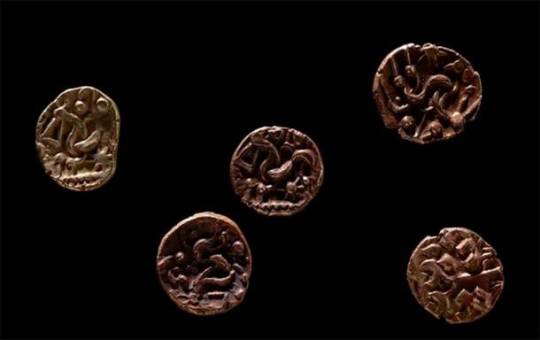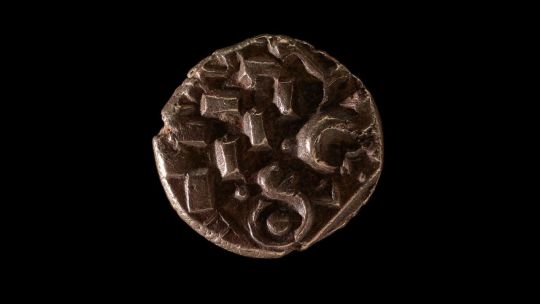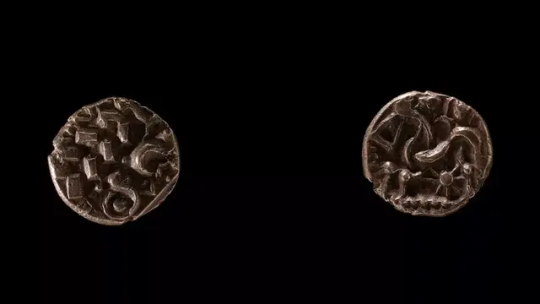#A 2000-Year-old Iron Age Gold Treasure Found in Wales
Explore tagged Tumblr posts
Text

A 2,000-Year-old Iron Age Gold Treasure Found in Wales
Gold coins dating back more than 2,000 years have been found by metal detectorists in Wales, making them the first hoard of Iron Age gold coins to have been discovered in the country.
The 15 coins, which have been declared treasure, are known as staters. They were found the Welsh island of Anglesey, off the northwest coast of the country’s mainland.
Struck between 60 BC and 20 BC, the coins belonged to the Corieltavi tribe, who at the time inhabited the geographical area that is now England’s East Midlands, according to a National Museum Wales press release.
The precious metals were unearthed by three metal detectorists in a field between July 2021 and March 2022.
Lloyd Roberts, who said he has been a metal detectorist for more than 14 years, found the first coin.
“Finding a gold stater was always number one on my wish list,” he said in the release, adding: “That one coin alone would have made my year, but I went on to find another on my next signal.”

Roberts said that his friend, Peter Cockton, found the next three. They then contacted the Portable Antiquities Scheme, an organization which records such historical and archaeological finds.
Tim Watson, who said he only began metal detecting following encouragement from his father during lockdown, found the sixth.
“I rushed home to show my wife and we were both in awe of this coin, which was like nothing else I had found, immaculately preserved with such unusual stylised images,” Watson said in the release.
Watson said his enthusiasm led him to upgrade his metal detector and he found the remaining nine coins in the following weeks.
‘Rich archaeological landscape’
The gold coins’ elaborate design derives from those of Philip II, who ruled the ancient kingdom of Macedonia from 359 BC to 336 BC. The heads side of the coins shows the mythological deity Apollo’s wreath and hair, while the tails side shows a triangular-headed horse surrounded by symbols.
The coins were likely not used for everyday transactions, except potentially for some high-value purchases, according to the release. Instead, the staters are thought to have been used as gifts between the elites to secure alliances or show loyalty.

Another option is that the Corieltavi tribe used them to form part of an exchange for copper, which there were sources of in various parts of the island.
The staters could also have been used as “offerings to the gods” to fulfill a vow, according to National Museum Wales. Other archaeological finds from Anglesey, as well as Roman sources referring to the island that feature pagan priests, suggest the area was an important religious center at the time.
Gwynedd Archaeological Trust visited the site in September 2021 to see if there were any clues as to why the coins were buried there.
“This hoard is a fantastic example of the rich archaeological landscape that exists in North-West Wales,” said Sean Derby, Historic Environment Record archaeologist at Gwynedd Archaeological Trust. “While the immediate vicinity of the find did not yield any clues as to the find’s origin, the findspot lies in an area of known prehistoric and early Roman activity and helps increase our understanding of this region.”
Welsh museum Oriel Môn is looking to acquire the coins and put them on public display.
By Amarachi Orie.



#A 2000-Year-old Iron Age Gold Treasure Found in Wales#gold#gold coins#collectable coins#treasure#metal detecting#ancient artifacts#archeology#archeolgst#history#history news#ancient history#ancient culture#ancient civilizations#the Corieltavi tribe
167 notes
·
View notes
Link
[ad_1] Metal detectorists have struck gold in Wales, finding a hoard of 2000-year-old treasure from the Iron Age, the first of its kind to be discovered in the country.The 15 coins, known as staters, were found on the Welsh island of Anglesey off the northwest coast of the mainland by three metal detectorists between July 2021 and March 2022. Lloyd Roberts, who found the first two coins of the hoard, said finding a gold stater was “always number one on my wish list”.He said in his 14 years of metal detecting, he never expected to find even one stater, let alone two while on a search with his friend Peter Cockton. “Having never expected to actually find one, let alone in Anglesey, can you imagine my shock, delight and surprise as I called out to my friend Peter, having dug up a beautiful full gold stater in mint condition?!” Mr Roberts said in a statement to the National Museum of Wales. “That one coin alone would have made my year, but I went on to find another on my next signal, and then Peter found a total of three.”After finding the coins, the pair contacted the Portable Antiquities Scheme – an organisation which records such finds – and sat on the spot for a coffee and to imagine “what our surroundings and people’s lives were like over 2000 years ago”.The coins were struck between 60BC and 20BC and belonged to the Corieltavi tribe who, at the time, inhabited the geographical area that is now England’s East Midlands, according to the Museum.Tim Watson, who said he was relatively new to metal detecting after being encouraged by his father to “give it a go” during lockdown, found the sixth coin.“I rushed home to show my wife and we were both in awe of this coin, which was like nothing else I had found, immaculately preserved with such unusual stylised images,” Mr Watson said in the release.The discovery inspired Mr Watson to upgrade his metal detector, which helped him find the remaining nine coins in the same area in the following weeks.The Museum says the coins’ stylised design derives from those of Philip II, who ruled the ancient kingdom of Macedonia from 359BC to 336BC.The coins show the wreath and hair of mythical deity Apollo on the ‘heads’ side, while the ‘tails’ side shows a triangular-headed horse surrounded by various symbols which are key to separating the coins into their different types.They were likely not used for everyday transactions as modern societies use coins today – though some were thought to have been used for high-value purchases – but were instead used as gifts between the elites to secure alliances, or as offerings to the gods. The coins may also have been used in an exchange by the Coreltavi for copper, which were sourced from the Parys Mountain on Anglesey and the nearby Great Orme. Another hypothesis that archaeologists and historians are using to explain the discovery of the buried treasure is the “holy nature of the island”. Gwynedd Archaeological Trust visited the findspot in 2021 in an effort to find archaeological clues at to why the coins were buried.The Trust’s Historic Environment Record archaeologist Sean Derby said while there were no clues found on the surface, “the findspot lies in an area of known prehistoric and early Roman activity”.Other archaeological finds from Anglesey as well as Roman sources referring to the island and pagan priests suggest the area was an “important religious centre during the first centuries BC and AD”.Welsh museum Oriel Môn is looking to acquire the coins and put them on public display. [ad_2]
0 notes
Text
British Bird-Watcher Discovers Trove of 2,000-Year-Old Celtic Coins
https://sciencespies.com/history/british-bird-watcher-discovers-trove-of-2000-year-old-celtic-coins/
British Bird-Watcher Discovers Trove of 2,000-Year-Old Celtic Coins

This September, a British birder who’d stopped on the edge of a farmer’s field to watch a buzzard and a pair of magpies stumbled onto a trove of 2,000-year-old Celtic coins worth an estimated £845,000 (around $1,150,000 USD).
As first reported by Julian Evan-Hart of Treasure Hunting magazine, the unnamed bird-watcher—who is also an amateur metal detectorist—unearthed the stash of some 1,300 gold coins in a field in the eastern English countryside. Dated to between roughly 40 and 50 A.D., the cache is the largest hoard of Iron Age Celtic coins found in the United Kingdom since 2008, when a car mechanic excavated a stash of 850 ancient staters, or handmade money, in Suffolk.
“I saw the glint of gold and realized it was a beautiful Celtic gold stater, which made me sit down in sheer shock,” the birder tells Treasure Hunting, as quoted by the Daily Mail’s Luke May. “I then spotted the second coin two feet away and rushed home to get my [metal detector].”
Upon his return, the man found that his detector produced a “really strong” signal—a sure sign that more treasures lingered below the surface. Digging down about 18 inches, he extracted a copper vessel brimming with gold coins dated back to the era when Celtic queen Boudica led a massive uprising against the Romans.
“I had to sit down to get my breath back,” the treasure hunter says. “I had only come out for a walk and found a Celtic hoard.”
Once the man overcame his initial shock, he filled two large shopping bags with the cache of coins and returned home. Then, he promptly contacted local authorities to report the find. If experts deem the discovery treasure, they will offer it to a museum and potentially offer a share of the reward to the finder. (Current guidelines define treasure very narrowly, but as Caroline Davies reports for the Guardian, the U.K. government is working to expand these parameters in order to better protect the country’s national heritage items.)
“The coins form a substantial if not enormous contribution to our academic numismatic knowledge and will undoubtedly be subject to much assessment over the coming year,” says Jules Evan-Hart, editor of Treasure Hunting, in a statement quoted by the New York Post’s Hannah Sparks. “It is possible that [the coins] may form a deposit as a ‘war chest’ for Boudica’s eastern campaigns.”

A 19th-century engraving of Boudica
(Public domain via Wikimedia Commons)
A towering figure in British history, Boudica was an ancient warrior queen who revolted against the Romans following her husband’s death in 60 A.D. Prasutagus—king of the Iceni, a tribe based in what is now Norfolk—had no male heir, so he bequeathed half of his assets to his daughters and the other half to Nero in the hope that the Roman emperor would protect his family. Unfortunately, Prasutagus’ efforts were in vain: The Romans seized and plundered his land, in addition to raping his daughters and publicly beating his widow. Enraged, Boudica raised a bloody rebellion throughout East Anglia; the Roman historian Tacitus later wrote that her forces killed around 70,000 Romans and pro-Roman Britons during attacks on three separate settlements. Despite these early victories, Boudica’s army eventually faltered. A smaller Roman force defeated the rebels in a final battle at an unknown location, slaughtering around 80,000 Britons while incurring casualties of just 400 men, as Richard Hingley noted for National Geographic in 2019.
The two historians who mention Boudica in their accounts—Tacitus and Dio Cassius—offer differing versions of her fate. According to Tacitus, the queen poisoned herself after suffering defeat. Dio Cassius, however, suggests that she fell ill, died and received an elaborate burial.
Boudica’s people, the Iceni, may have used gold staters as votive offerings in times of political duress, drought or natural disaster, wrote David Keys for the Independent in 2009.
Speaking with BBC News in 2019, archaeologist Anna Booth said that Boudica’s uprising marked a tumultuous time in the region, and as a result, many people may have hoarded coins. At one major religious center, the tribe buried more than 60 pounds of gold and silver jewelry, according to the Independent.
“There does seem to be a slight increase in hoarding in this period,” Booth told BBC News. “It is a stretch of the imagination, we are not 100 percent sure, but in this region, it is tempting to say this is because of what was happening in this period.”
The Iron Age coins are among more than 47,000 archaeological discoveries made in England and Wales this year, according to a statement released by the British Museum. Officials reported that Covid-19 restrictions led to an increase in finds, with many pandemic-worn Brits seeking respite outdoors. Finds included gold coins inscribed with the initials of Henry VIII’s first three wives, rare Saxon pennies and a copper Roman furniture fitting.
#History
0 notes